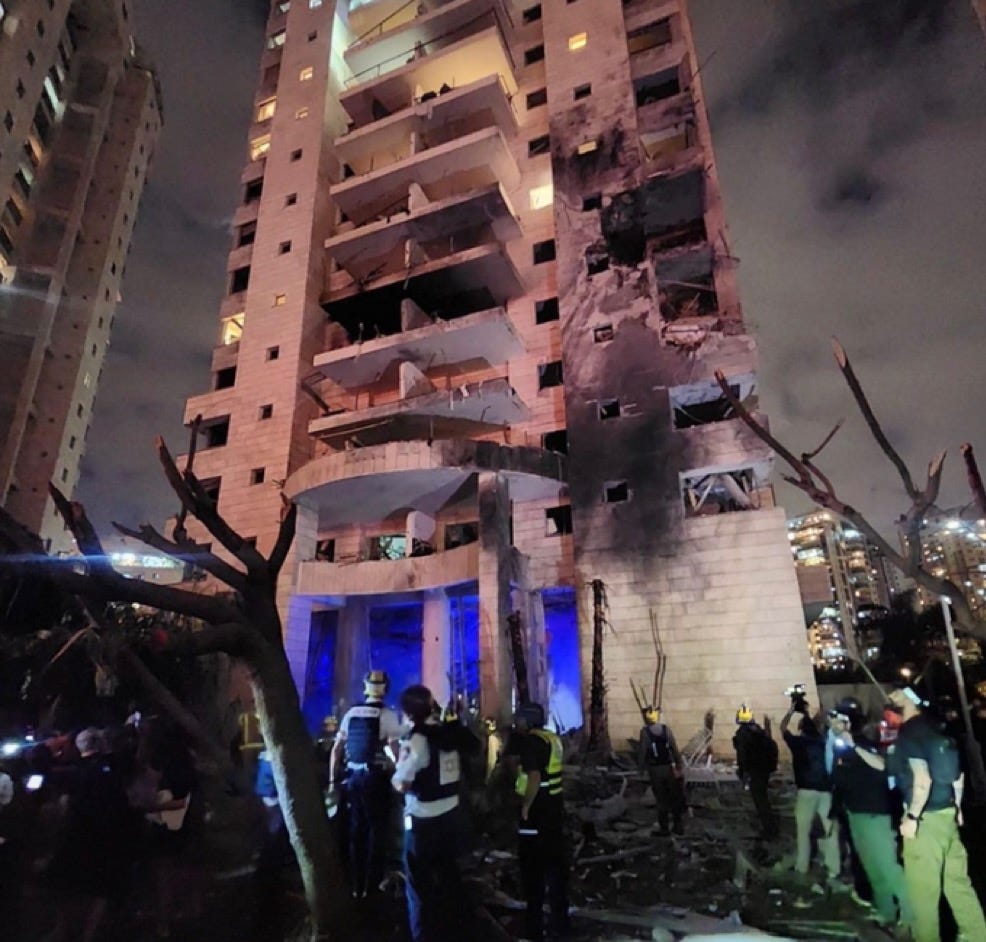DAY 4 OF THE WAR WITH IRAN • DAY 619 OF THE WAR: Soldier Killed in Gaza; Eight Dead in Missile Attacks On Israel; IDF Destroys 1/3 of Iranian Missile Launchers
Tel Aviv Diary, June 16, 2025
While the war with Iran continues to dominate public attention, combat in Gaza continues. Today, Captain Tal Movshovitz (28), from Reut, was killed by an improvised explosive device (IED) in Khan Younis. And still, 53 hostages remain trapped in Gaza—held in unimaginable conditions, their fate uncertain.
ATTACKS FROM IRAN
No two nights in this war in Tel Aviv are alike. Before last night’s update was even finished, I wrote about a missile attack that took place while we were editing. Once we got back upstairs and I released the update, I began to consider going to sleep a little early, knowing I’d likely be woken up in the middle of the night.
Just as I got into bed, a notification came in advising everyone to stay near bomb shelters or safe rooms—which ruled out going to sleep at that point. I got up, went back into the living room to watch the news, and we waited—and waited. Nothing happened. We were told that the Air Force was busy attacking missile sites in Iran, with the hope of destroying the missiles before they could be launched at us. As it turned out, that entire barrage was indeed intercepted by the Air Force—but we didn’t know that at the time.
I eventually fell asleep in the living room, woke up after an hour—still nothing—and then went to bed dressed, knowing it wouldn’t be for long. Sure enough, at four a.m. we received another warning. This time, it was followed by an actual missile alert siren. Once again, we all hurried into the bomb shelter. Shortly after arriving, we heard an explosion—this one at a bit of a distance. Not right on top of us, but clearly audible.
It turned out that missiles had landed in four locations. The one we heard struck downtown Tel Aviv, about a 20-minute walk from our home—a place we visit fairly often. This area is considered the old downtown. The images showed widespread destruction, mostly from the explosive force of the missile. Thankfully, no one was killed there, though several were wounded. There were reports that the American Consulate sustained minor damage. To my knowledge, this wasn’t the well-known building along the waterfront that most people associate with the U.S. Consulate, but rather a separate location in an office building—one I’ve visited many times during my work with the embassy—where some staff are based.
At the other three locations, people were not as fortunate. One of the rockets struck a 30-story apartment building in the suburb of Petah Tikva, hitting the safe rooms of two apartments—one directly above the other. Two people were killed while inside their safe rooms. This is the first time such a tragedy has occurred during this war. Safe rooms typically offer full protection from indirect hits. However, even a reinforced shelter room cannot withstand a direct hit from a 500-kilogram explosive warhead. In total, four people were killed at that site, including two who were not in safe rooms
.
Another rocket struck a youth center in B’nei Brak. There were almost no people present at the time. However, the bomb shelter at the center was locked—reflecting a broader issue in Bnei Brak, where many shelters are inaccessible. A nearby elderly man, who had not taken shelter, was killed by the blast. The youth center itself was completely flattened.
The final strike of the night targeted the petroleum refinery in Haifa Bay, igniting a fire that proved extremely difficult to contain and tragically claimed the lives of three people who were trapped by the flames. The attack also disabled the power plant that supplies the refinery, forcing a halt in production.
This morning, a missile launched by the Houthis triggered warning sirens in the Beersheba area. The missile was intercepted before it entered Israeli airspace.
Several warnings were issued this morning about Iranian drones entering Israeli airspace, both in the far north and over the Be'er Sheva Valley. Since the war began, Iran has launched over 140 drones at Israel. Thankfully, the Air Force has become highly effective at intercepting them—all have been downed before reaching their targets.
Tonight at 8:30PM, we received the early warning that Iran was planning a strike, and we should be near the protected spaces. The meaning of that warning was that Israeli intelligence had seen sounds that Iran was planning an attack. While we received the warning at home, the Israeli Air Force took action in the skies of Iran, destroying the launchers and preventing the attack.
Meanwhile, Israeli strikes on Iran continue. The focus shifted from western Iran—where Israel had initially concentrated its efforts—to central Iran, which, until last night, had remained untouched. Many of Iran’s missile launchers have been relocated to this region, which is farther from Israel than western areas of the country.
This morning, the IDF Spokesperson announced that one-third of Iran’s missile launchers have been destroyed by the Israeli Air Force since the start of the war. That seems to be the primary factor now limiting Iran’s ability to launch attacks on Israel.
Israel continues to strike targets across Iran at will. These attacks are based on a pre-planned target list, and according to Air Force sources, operations are at least 24 hours ahead of schedule. The strikes throughout Iran are proceeding much faster than expected.
What is also true—yet difficult to write considering our loses since the onset of this operation—is that Iran has been far less effective than initially feared in its attempts to strike Israeli cities and inflict mass casualties or widespread damage. Every life lost is a world unto itself, and we must never take that lightly. However, early assessments of Iran’s capabilities were significantly higher, resembling projections made for a potential war with Hezbollah—projections that have likewise proven to be overestimates.
As one friend wrote today: who would have believed that Israel could establish such overwhelming dominance over Iran so quickly? Tonight, after issuing a warning to those in the complex, Israel struck the Iranian government television network, taking it off the air temporary. The IDF also continues targeted eliminations of senior Iranian officials, carried out both by air and from on the ground.
Reports from Tehran indicate that the Iranian government—growing increasingly paranoid—now suspects Mossad involvement everywhere. Authorities have arrested, and in some cases even executed, individuals without clear evidence of their identity or intentions.
IS AN IRAN AGREEMENT POSSIBLE?
Of course, none of this solves the underlying issue: how to prevent Iran from acquiring nuclear weapons. As I wrote last night, that can only happen through one of two outcomes—an agreement, or the fall of the regime. Let’s set aside regime change for the moment, as that would require action from within Iran. Perhaps that’s already happening—maybe not. But let’s focus on the possibility of an agreement.
Today, The Wall Street Journal reported news that was quickly picked up by the Israeli media—that Iran, through Arab intermediaries, has offered a ceasefire with Israel and a return to negotiations with the United States. Their condition: that the U.S. stay out of the war.
I doubt such a deal would be acceptable to Israel. I don’t believe we’re prepared to return to the negotiating table and engage in yet another drawn-out, multi-month process filled with Iranian stalling tactics. From the Israeli perspective, halting this war would require a prior commitment from Iran to end its nuclear program—at the very least, a complete halt to uranium enrichment.
Keep reading with a 7-day free trial
Subscribe to Tel Aviv Diary to keep reading this post and get 7 days of free access to the full post archives.





